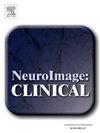灰质定量易感性定位信号与临床特征和衰老相关MRI标志物的关联:动脉粥样硬化的多民族研究。
IF 3.6
2区 医学
Q2 NEUROIMAGING
引用次数: 0
摘要
背景和目的:在神经病理学研究中,灰质中的铁积累(GM)与衰老和特定的神经系统疾病有关,但在社区人群中对其相关性知之甚少。方法:在多民族动脉粥样硬化研究中,于2018-2019年进行脑MRI。为了估计铁含量,我们从四个区域:基底神经节和额叶、颞叶和顶叶的皮质GM提取了中位数定量敏感性映射(QSM)信号。我们研究了人口统计学和临床特征、认知测试表现、步态速度以及萎缩和小血管疾病的脑MRI测量的横断面关联。结果:我们研究了943名参与者(14%的中国人,25%的黑人,20%的西班牙人,41%的白人,平均年龄74岁,48%的男性)。在多变量模型中,较高的左基底节区QSM信号与年龄较大(每10年7.2 ppb; 95% CI 4.6,9.9)、吸烟(7.1;3.4,10.9)和糖尿病(7.4;2.5,12.3)相关。较低的QSM信号与黑人(-15.3;-20.6,-10,相对于白人)和较高的高密度脂蛋白胆固醇(-3.4 / 20mg /dL; -5.8,-0.9)相关。在皮质GM中,QSM信号与更大的腰围、终生饮酒和对数转换白质高强度(WMH)体积(每SD 0.08-0.12 SD单位,均p≤0.002)相关,但与认知测试表现或步态速度无关。讨论:在基于社区的队列横断面分析中,年龄较大、白人、吸烟、糖尿病和WMH体积较大与基底节区和/或皮质GM中较高的QSM信号相关。需要进行纵向研究以进一步探索GM QSM信号与老年人认知和步态的关系。本文章由计算机程序翻译,如有差异,请以英文原文为准。

Association of quantitative susceptibility mapping signal in gray matter with clinical characteristics and aging-related MRI markers: The Multi-Ethnic Study of Atherosclerosis
Background and objectives
In neuropathologic studies, iron accumulation in gray matter (GM) is associated with aging and specific neurological diseases, but less is known about its correlates in community-based populations.
Methods
In the Multi-Ethnic Study of Atherosclerosis, brain MRI was conducted in 2018–2019. To estimate iron content, we derived the median quantitative susceptibility mapping (QSM) signal from four regions: the basal ganglia and cortical GM of the frontal, temporal, and parietal lobes. We examined cross-sectional associations with demographic and clinical characteristics, cognitive test performance, gait speed, and brain MRI measures of atrophy and small vessel disease.
Results
We studied 943 participants (14 % Chinese, 25 % Black, 20 % Hispanic, 41 % White; mean age 74 years; 48 % men). In multivariable models, higher left basal ganglia QSM signal was associated with older age (7.2 ppb per 10 years; 95 %CI 4.6,9.9), smoking (7.1; 3.4,10.9), and diabetes (7.4; 2.5,12.3). Lower QSM signal was associated with Black race (−15.3; −20.6,-10, relative to White) and higher high-density lipoprotein cholesterol (−3.4 per 20 mg/dL; −5.8,-0.9). In cortical GM, QSM signal was associated with greater waist circumference, lifetime alcohol use, and log-transformed white matter hyperintensity (WMH) volume (0.08–0.12 SD units per SD, all p ≤ 0.002), but not with cognitive test performance or gait speed.
Discussion
In cross-sectional analyses in a community-based cohort, older age, White race, smoking, diabetes, and greater WMH volume were associated with higher QSM signal in basal ganglia and/or cortical GM. Longitudinal studies are needed to further explore GM QSM signal in relation to cognition and gait in older individuals.
求助全文
通过发布文献求助,成功后即可免费获取论文全文。
去求助
来源期刊

Neuroimage-Clinical
NEUROIMAGING-
CiteScore
7.50
自引率
4.80%
发文量
368
审稿时长
52 days
期刊介绍:
NeuroImage: Clinical, a journal of diseases, disorders and syndromes involving the Nervous System, provides a vehicle for communicating important advances in the study of abnormal structure-function relationships of the human nervous system based on imaging.
The focus of NeuroImage: Clinical is on defining changes to the brain associated with primary neurologic and psychiatric diseases and disorders of the nervous system as well as behavioral syndromes and developmental conditions. The main criterion for judging papers is the extent of scientific advancement in the understanding of the pathophysiologic mechanisms of diseases and disorders, in identification of functional models that link clinical signs and symptoms with brain function and in the creation of image based tools applicable to a broad range of clinical needs including diagnosis, monitoring and tracking of illness, predicting therapeutic response and development of new treatments. Papers dealing with structure and function in animal models will also be considered if they reveal mechanisms that can be readily translated to human conditions.
 求助内容:
求助内容: 应助结果提醒方式:
应助结果提醒方式:


